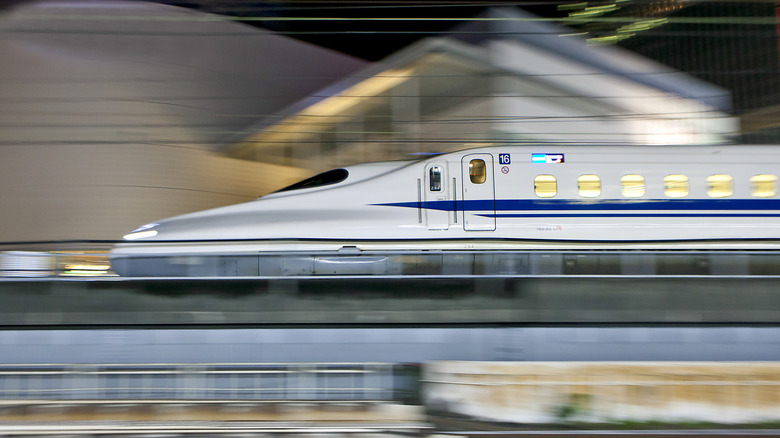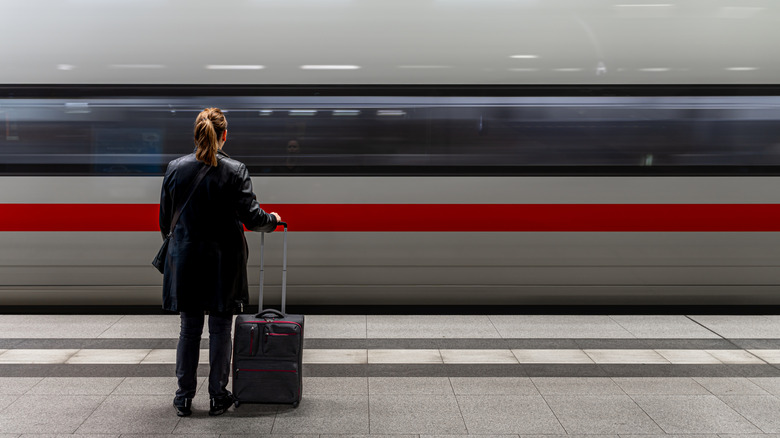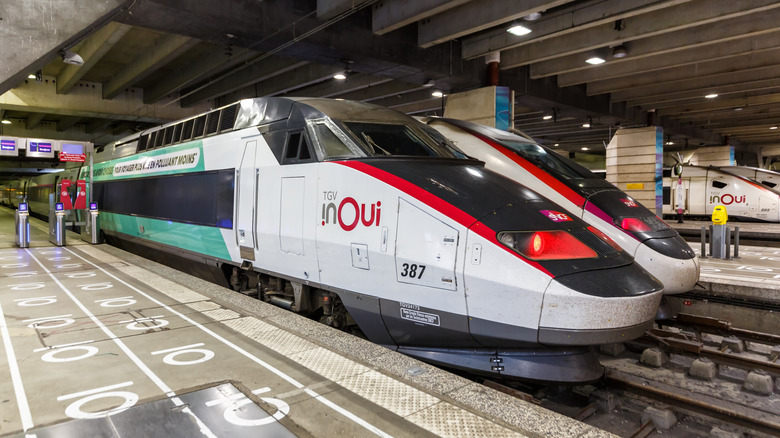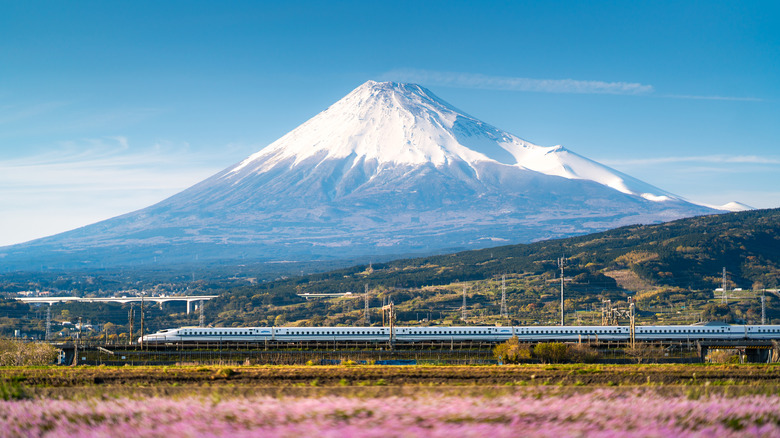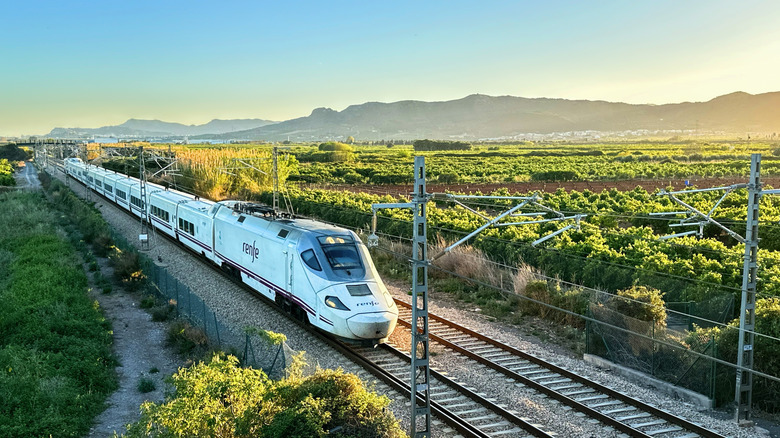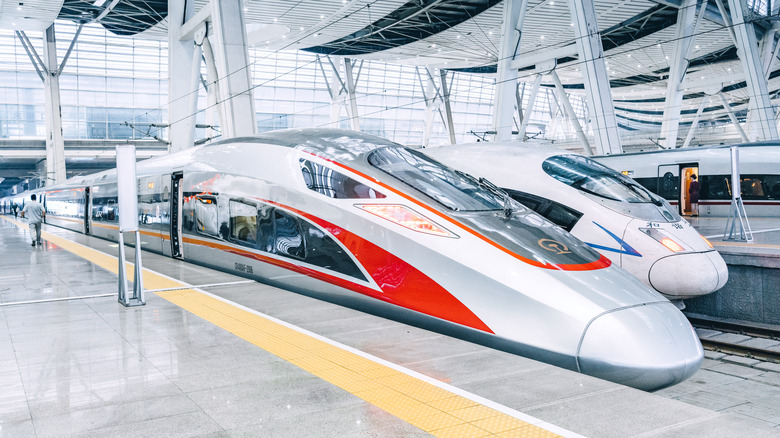The Top Five Countries That Boast The Most High-Speed Rail In The World
High-speed train travel is one of the most convenient and affordable ways to get around while traveling. Whether you're looking to go one city over or travel between interconnected countries, these railways are stunning technological accomplishments. The criteria for a train to be considered "high-speed" is that it travels over 125 mph, with some able to go as fast as 220 mph. The trains are globally recognized for their sleek, modern design and comfortable seating.
This form of public transportation is essential in connecting people both domestically and internationally, and in some cases, competes with flying or driving as the best way to reach your destination. For instance, Rick Steves considers train travel in Europe to be better than driving. It makes passing between other countries easy and accessible, and is a fun way to see the country. As of 2025, Germany, France, Japan, Spain, and China have the fastest high-speed railway systems in the world. Here's how fast they really go and how you can experience high-speed rail on your next trip. This list only considers countries with the highest amount of high-speed rails that are currently in operation, not those that are planned or in progress.
Germany
Coming in at fifth place, Germany's high-speed rail system covers roughly 976 miles of land. The high-speed Inter City Express (ICE) trains can get you from one side of the country to the other in just a few hours. For example, you can travel from the heart of Hamburg in the northern part of the country to the lively neighborhoods of Munich in the south in just six hours. This is thanks to the train's speed, which can reach 186 mph.
The Inter City Express Trains began construction in the late 1980s, with their first route opening in 1991. The routes have expanded to connect all major German hubs, as well as some international routes to Austria, Belgium, France, Switzerland, and the Netherlands. While reservations are optional, be sure to plan your intercity transportation with the ICE train to make travel swifter and more affordable — you can reserve your seat for under $10.
France
Just next to Germany is the country with the next highest amount of high-speed rail in the world. France is home to the impressive Train à Grande Vitesse (TGV). The 1,700-mile network connects bustling city centers like Paris, Nice, and Geneva, and even offers international routes to Germany, Italy, Belgium, Luxembourg, and Spain.
Owned and operated by the Société Nationale des Chemins de Fer Français (SNCF), the first high-speed route on the TGV network was from Paris to Lyon and opened to the public in 1981. The train's casual operating speed moves at 168 mph, but some can reach up to 235 mph. Train reservations on the TGV are mandatory, and a bit more expensive than their German neighbors, with prices between $12 and $52. However, depending on which train you end up on, it could come with onboard features such as power sockets, a restaurant or bar, or a children's play area.
Japan
Third on the list of countries with the most high-speed rails in the world is a country renowned for its technological advancement: Japan. Living up to its reputation, Japan was actually the first country to put high-speed trains into use in 1964. You may have heard of the Shinkansen, or Japan's iconic bullet trains. The 1,914-mile track encompasses nine rail lines spanning the entire length of the country. The lines are complete with fast, semi-fast, and local trains, with the Tokaido Shinkansen line reigning as the most popular. Known for their lightning-fast speeds, some trains can travel up to 200 mph.
Shinkansen trains have comfortable, front-facing seating, reminiscent of airplane seats. There are three seat classes: ordinary, green car, and green class, which get progressively more comfortable and more accommodating. Shinkansen trains have an impressive track record when it comes to safety and efficiency, with no fatal accidents in history, as well as their departure schedule timed down to the second. These trains have held the torch in train technology, often inspiring several other trains built globally, and are a must-do if you plan to visit Japan.
Spain
With 2,275 miles of track, Spain is home to the longest high-speed railway system in Europe, and the second-longest in the world. The Alta Velocidad (AVE) train network serves over 40 million passengers a year and connects all of Spain's major cities, from Madrid to Barcelona to Seville. With peak speeds of 193 mph, passengers are also able to travel to Lyon and Marseille, France. Depending on the train, travelers may be able to enjoy accommodations such as video screens, a coffee bar, and magazines.
Utilizing the AVE is the perfect way to make the most out of your vacation to Spain. You can travel seamlessly across the country to make sure you are able to spot all of the iconic Spanish tourist sights, such as the Prado Museum and the Sagrada Família (just make sure you avoid this dangerous TikTok trend). Prices for reservations sit between $12 and $30, and can be made up to four months in advance.
China
In first place is China, which has exponentially surpassed every country on this list in terms of high-speed rail length. With a whopping 25,150 miles of high-speed track, China has no plans of slowing down soon. In fact, plans are for the railway length to almost double by 2035, giving 90% of China's population access to public trains. While China was relatively late to the production of high-speed trains — beginning construction in the early 2000s — it is now the frontrunner in high-speed rail development.
The rapid modernization of the rail system was driven by the government's desire for social cohesion and interconnected cities, big and small. Most major routes revolve around Beijing, with popular routes including the Beijing to Shanghai High-Speed Rail, the Beijing to Guangzhou High-Speed Rail, and the Beijing to Harbin High-Speed Rail. However, there are routes that reach into the mountains and cities as far as Lhasa (in Tibet) and Ürümqi (in the Uyghur region).
